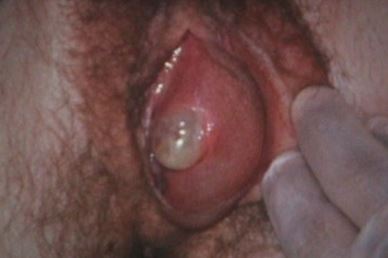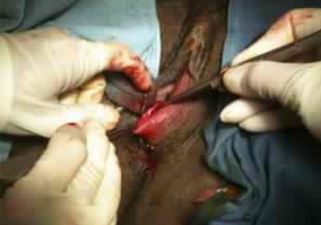Bartholin Cyst
What is Bartholin Cyst?
Bartholin cyst is the growth of a small tumor-like tissue on the Bartholin’s gland. The Bartholin’s gland is a pea-sized gland located on the side of the vaginal opening. The Bartholin’s gland is usually small and non-palpable, but the occurrence of a cyst makes it swell or enlarge.
These glands, also termed as vestibular glands are located underneath the skin in the vaginal orifice. The Bartholin’s glands in females are very important during sexual intercourse. These glands are responsible for secreting mucus, which serves as lubrication for the vagina during sexual intercourse.
Any obstruction in the duct causes the fluids to accumulate inside it. As a result, there is inability to release the fluid for use. When significant accumulation happens, it usually forms a cyst on the area.
Bartholin cyst is commonly the size of a pea or a marble. However, when it becomes infected, it can grow bigger with resulting abscess formation. The cyst is usually painless and cyst in only one duct is more common.
The presence of infection and abscess formation causes the cyst to become very uncomfortable. However, the cyst is usually benign. Tumors, cancers or hyperplasia in the glands are not common.

Left Bartholin Cyst Abcess
Image source: brooksidepress.org
Bartholin Cyst Symptoms
Bartholin cysts have different symptom for infected and uninfected lesions. Uninfected cysts usually result to the following manifestations:
- Presence of small lump in the vulva
- Usually painless
- Redness in the area
- Swelling of the vaginal orifice
- Cysts are a quarter to one inch in size
- Enlarges during sexual intercourse because of more fluid accumulation
- Pain during intercourse or dyspareunia as a result of lack of lubrication from the obstructed duct
- Infected Bartholin cysts lead to the following symptoms:
- Severe pain on the cyst
- Difficulty sitting or walking because of pressure and pain on the area
- Tenderness in the surrounding tissues
- Formation of abscess, which may be foul smelling
- Fever as a sign of severe infection
- Vaginal discharges may be present as a sign of underlying sexually transmitted disease
Bartholin Cyst Causes
The primary cause of Bartholin cysts is the presence of accumulation in the Bartholin duct. This is caused by various factors such as:
Poor Personal Hygiene
Poor perineal care after sexual intercourse leads to obstruction of the duct by various materials. Poor hygiene may also cause infection in the area leading to Bartholin cysts.
Infection
Presence of sexually transmitted diseases is a common cause of Bartholin cyst. STDs lead to vaginal discharges that when lodges on the Bartholin’s ducts, it may cause obstruction and Bartholin cyst. Bacteria from the colon, which is Escherichia coli, can also go to the Bartholin’s duct and cause cyst formation.
Use of restrictive undergarments and pants
Young women suffering from Bartholin cyst usually develop it because of wearing of ill-fitting clothes. These clothes limit air circulation in the area and also restrict blood circulation. The Bartholin’s gland secretions may also not effectively escape the duct because of restriction and further leads to accumulation and blockage.
Bartholin Cyst Diagnosis
The primary diagnosis of Bartholin cyst involves physical examination of the vulva showing palpable mass on the vaginal orifice. Gynecologists usually do not perform other diagnostic tests when the cysts are not infected or uncomplicated.
However, when infection is observed such as the occurrence of abscess and vaginal discharges, the physician usually does other tests to identify the causative organism and the appropriate antibiotic therapy. Specific tests include:
Culture and Sensitivity Testing
This test involves the collection of pus on the area and subjecting it to culture to determine the specific bacteria. Next, sensitivity testing is done by subjecting the cultures to various antibiotics. The antibiotic to which the bacteria are most sensitive will be the drug of choice for the patient.
Smears
Smearing of the vagina and the cervix is also done to identify possible sexually transmitted disease in sexually active women. Gonorrhea and Chlamydia are the most common STDs that may cause Bartholin cyst.
Bartholin Cyst Treatment
Other patients may recover from Bartholin’s cyst without treatment because the cysts sometimes disappear on their own. However, most women seek treatment because of occurrence of pain, significant size of the cysts and difficulty in walking or sitting. Infected cysts become severely painful, which prompts patients for consult. The treatment of Bartholin cyst usually involves medications, surgery, as well as home treatments. These include:
Home Treatments
- Hot sitz bath
Hot sitz bath is done to promote blood, circulation, drainage and healing of the cyst. Hot sitz bath involves exposing the vulva to hot steam because a hot temperature dilates the blood vessels as well as the duct. This is done at home by sitting in a tub of warm water three times a day for 15 minutes. It can also be done by sitting in a pail of water in order to prevent the water from touching the skin and allowing only the steam to reach the vulva. This technique may also help mature the cyst for easier surgical removal.
- Proper perineal care
Washing the perineum with lukewarm water prevents the development of infection. It also hastens the healing of the Bartholin’s duct.
Medications
- Analgesics
- Analgesics are taken to reduce the pain especially for infected Bartholin’s cyst. Common analgesics include ibuprofen and acetaminophen.
- Antibiotic therapy
- Oral antibiotics are also taken for infected cysts. These should be taken for a course of days to allow the microorganism to be completely eradicated.
Surgical Excision
Excision involves the removal of the cyst by the use of instruments. This is done in an outpatient basis. Excision is the treatment of choice for uninfected cyst in order to prevent reoccurrence of the growth. It is performed under a local anesthesia.
Marsupialization
Marsupialization is also a surgical procedure involving the drainage of the abscess along with the removal of the cyst in infected Bartholin’s cysts. This is also done in an out-patient unit and performed under local anesthesia. However, it may still cause significant discomfort because local anesthetics do not act fully in infected Bartholin’s cyst. Sedation may be employed depending on the physician.
The procedure is started by making a small incision to drain the abscess. After which, the cyst is excised and the cyst wall is sutured to prevent re-growth or reoccurrence of the cyst.

Marsupialization to drain and remove bartholin cyst and abcess
Complications of Bartholin Cyst
The primary complication of Bartholin cysts is infection. For cysts that are not surgically removed, it may disappear and reoccur from time to time. Presence of malignancies is usually uncommon for Bartholin cyst.